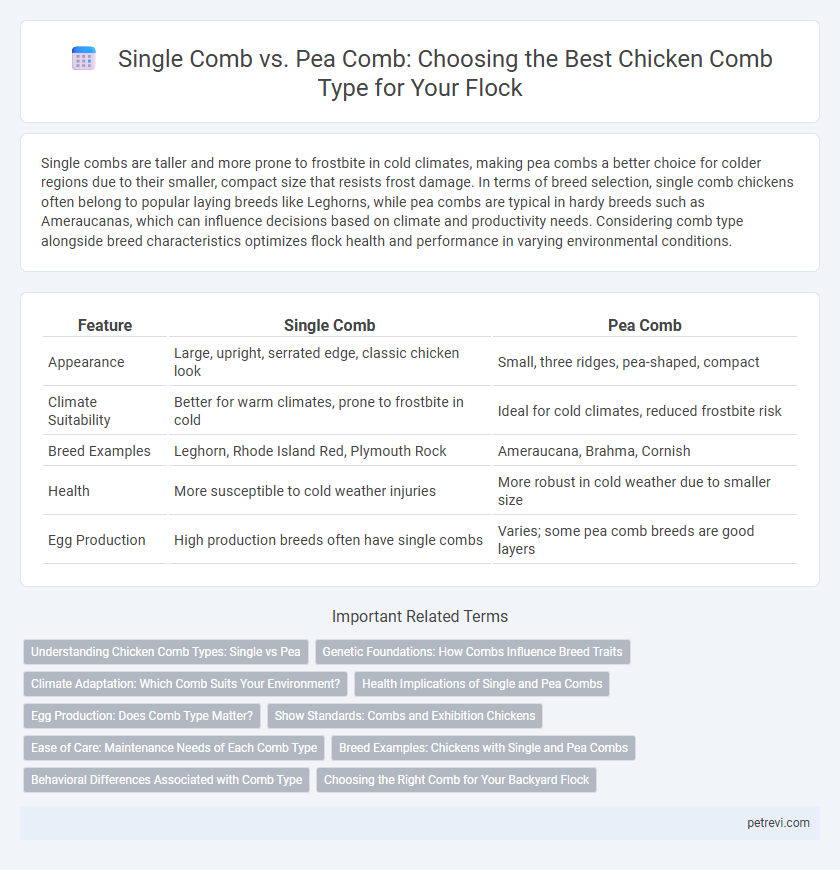Single combs are taller and more prone to frostbite in cold climates, making pea combs a better choice for colder regions due to their smaller, compact size that resists frost damage. In terms of breed selection, single comb chickens often belong to popular laying breeds like Leghorns, while pea combs are typical in hardy breeds such as Ameraucanas, which can influence decisions based on climate and productivity needs. Considering comb type alongside breed characteristics optimizes flock health and performance in varying environmental conditions.
Table of Comparison
| Feature | Single Comb | Pea Comb |
|---|---|---|
| Appearance | Large, upright, serrated edge, classic chicken look | Small, three ridges, pea-shaped, compact |
| Climate Suitability | Better for warm climates, prone to frostbite in cold | Ideal for cold climates, reduced frostbite risk |
| Breed Examples | Leghorn, Rhode Island Red, Plymouth Rock | Ameraucana, Brahma, Cornish |
| Health | More susceptible to cold weather injuries | More robust in cold weather due to smaller size |
| Egg Production | High production breeds often have single combs | Varies; some pea comb breeds are good layers |
Understanding Chicken Comb Types: Single vs Pea
Single combs are a common chicken comb type characterized by a single row of upright points, providing better heat dissipation in warmer climates, while pea combs consist of three small ridges and offer more frost resistance in cold environments. Breed selection based on comb type can enhance chicken health and productivity by matching environmental conditions and minimizing frostbite risk. Understanding these differences helps poultry keepers optimize breed performance and welfare through informed genetic and climate considerations.
Genetic Foundations: How Combs Influence Breed Traits
Single comb and pea comb genetics play a crucial role in defining breed characteristics and adaptability in chickens. The single comb, controlled by a dominant allele, is often linked with better heat dissipation and higher egg production in certain breeds, while the pea comb, governed by a specific mutation in the SOX5 gene, provides enhanced cold resistance and reduced frostbite risk. Understanding the genetic foundation of comb types aids breeders in selecting chickens optimized for environmental conditions and desired production traits.
Climate Adaptation: Which Comb Suits Your Environment?
Single comb chickens are better suited for warm climates due to their larger surface area, which enhances heat dissipation and helps prevent heat stress. Pea combs, smaller and more compact, are advantageous in cold environments as they reduce the risk of frostbite and heat loss. Choosing the appropriate comb type based on climate can improve chicken health and productivity.
Health Implications of Single and Pea Combs
Single comb chickens are more prone to frostbite due to their larger, exposed comb size, especially in cold climates, while pea combs have a smaller, more compact structure that better resists frost damage. Pea comb breeds, such as the Ameraucana, often face fewer health issues related to comb injuries or infections compared to single comb breeds like the Rhode Island Red. Selecting pea comb chickens can improve overall flock health in colder regions by reducing the risk of frostbite and related complications.
Egg Production: Does Comb Type Matter?
Single comb chickens generally exhibit higher egg production rates compared to pea comb breeds due to better heat dissipation, which supports consistent laying in warmer climates. Pea combs, often found in hardy breeds like Brahmas and Cochins, provide an advantage in cold weather by reducing frostbite risk but may slightly reduce egg output. Selecting a chicken breed for optimal egg production should consider comb type in relation to regional climate to maximize laying performance.
Show Standards: Combs and Exhibition Chickens
Single combs are often preferred in show standards for exhibition chickens due to their symmetrical shape and smooth surface, which align with breed standards like the Leghorn and Plymouth Rock. Pea combs, characterized by three distinct ridges and compact size, are favored in breeds such as the Brahma and Ameraucana for their unique appearance and resistance to frostbite. Selection between single and pea combs in show chickens hinges on breed-specific guidelines and the visual appeal mandated by poultry exhibitions.
Ease of Care: Maintenance Needs of Each Comb Type
Single combs require more frequent monitoring and care due to their susceptibility to frostbite and injury, making them higher maintenance for chicken owners in colder climates. Pea combs offer enhanced durability and resistance to harsh weather conditions, reducing the need for constant care and making them ideal for backyard flocks seeking low-maintenance breeds. Selecting breeds with pea combs can simplify daily care routines, especially in environments prone to moisture and cold.
Breed Examples: Chickens with Single and Pea Combs
Single combs are common in breeds like Leghorns and Rhode Island Reds, offering better heat dissipation due to their larger surface area. Pea combs, found in breeds such as Ameraucana and Brahma, provide greater frost resistance, making them suitable for colder climates. Choosing a breed based on comb type influences comfort and adaptability in different environmental conditions.
Behavioral Differences Associated with Comb Type
Single comb chickens tend to exhibit more active and assertive behavior, often dominating others in the flock due to their prominent, larger comb which may play a role in social signaling. Pea comb chickens generally show calmer and more docile tendencies, making them suitable for quieter environments or mixed-species setups. Understanding these behavioral differences linked to comb type helps breeders select chickens that match specific temperament needs and flock dynamics.
Choosing the Right Comb for Your Backyard Flock
Single comb chickens feature a tall, upright ridge with distinct points, providing better heat dissipation in warmer climates, making them ideal for backyard flocks in hot regions. Pea comb chickens, characterized by a low, rounded, and bumpy structure, are more resistant to frostbite and cold weather, suitable for colder environments or drafty coops. Selecting the right comb type balances climate adaptability and flock health, boosting comfort and productivity in your backyard chicken breed selection.
Single Comb vs Pea Comb for Chicken Breed Selection Infographic

 petrevi.com
petrevi.com